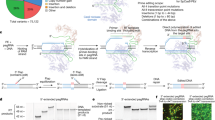Abstract
IN the past decade there has been increasing interest in cloning DNA from ancient and preserved tissues1–6. Most studies, however, have focused on mitochondrial or chloroplast genes, present at hundreds to thousands of copies per cell compared with one or two for each nuclear gene7–9. With a probe containing Alu repeat sequences, Pääbo isolated a 3.4-kilobase DNA fragment from a 2,400-year-old Egyptian mummy10 which was subsequently shown to contain an intron of the nuclear gene HLA-DQA (ref. 11). Here we report a more targeted approach to the characterization of nuclear genes from archaeological specimens. The Windover pond of central Florida has provided skeletal and soft tissue remains from 165 humans, radiocarbon-dated to be 6,990–8,130 years old12–14. Using DNA obtained from one individual we have characterized segments from six nuclear genes: that for β2-microglobulin and five members of the class I HLA heavy chain gene family. Distinctive patterns of nucleotide substitution in the cloned heavy chain gene segments permit tentative assignment of the HLA-A,B type of the ancient individual.
This is a preview of subscription content, access via your institution
Access options
Subscribe to this journal
Receive 51 print issues and online access
$199.00 per year
only $3.90 per issue
Buy this article
- Purchase on Springer Link
- Instant access to full article PDF
Prices may be subject to local taxes which are calculated during checkout
Similar content being viewed by others
References
Higuchi, R., Bowman, B., Freiberger, M., Ryder, O. A. & Wilson, A. C. Nature 312, 282–284 (1984).
Thomas, R. H., Schaffner, W., Wilson, A. C. & Pääbo, S. Nature 340, 465–467 (1989).
Hagelberg, E., Sykes, B. & Hedges, R. Nature 342, 485 (1989).
Golenberg, E. M. et al. Nature 344, 656–658 (1990).
Thomas, W. K., Pääbo, S., Villablanca, F. X. & Wilson, A. C. J. molec. Evol. 31, 101–112 (1990).
Pääbo, S., Gifford, J. A. & Wilson, A. C. Nucleic Acids Res. 16, 9775–9787 (1988).
Bogenhagen, D. & Clayton, D. A. J. biol. Chem. 249, 7991–7995 (1974).
Michaels, G. S., Hauswirth, W. W. & Laipis, P. J. Devl Biol. 94, 246–256 (1982).
Lamppa, G. K., Elliot, L. V. & Bendich, A. J. Planta 148, 437–443 (1980).
Pääbo, S. Nature 314, 644–645 (1985).
Del Pozzo, G. & Guardiola, J. Nature 339, 431–432 (1989).
Doran, G. H. et al. Nature 323, 803–806 (1986).
Doran, G. H. & Dickel, D. N. in Wet Site Archaeology (ed. Purdy, B.) 263–289 (Telford, Caldwell, New Jersey, 1988).
Doran, G. H. & Dickel, D. N. The Florida Anthropologist 41, 365–380 (1988).
Mullis, K. B. & Faloona, F. A. Meth. Enzym. 155, 335–350 (1987).
Suggs, S. V., Wallace, R. B., Hirose, T., Kawashima, E. H. & Itakura, K. Proc. natn. Acad. Sci. U.S.A. 78, 6613–6617 (1981).
Geraghty, D. E., Koller, B. H. & Orr, H. T. Proc. natn. Acad. Sci. U.S.A. 84, 9145–9149 (1987).
Ennis, P. D., Zemmour, J., Salter, R. D. & Parham, P. Proc. natn. Acad. Sci. U.S.A. 87, 2833–2837 (1990).
Kato, K., Trapani, J. A., Allopena, J., Dupont, B. & Yang, S. Y. J. Immun. 143, 3371–3378 (1989).
Koller, B. H. & Orr, H. T. J. Immun. 134, 2727–2733 (1985).
Pohla, H., Kuon, W., Tabaczewski, P., Doerner, C. & Weiss, E. H. Immunogenetics 29, 297–307 (1989).
Zemmour, J. et al. J. Immun. 144, 3619–3629 (1990).
Mayer, W. E. et al. EMBO J. 7, 2765–2774 (1988).
Parham, P., Lawlor, D. A., Lomen, C. E. & Ennis, P. D. J. Immun. 142, 3937–3950 (1989).
Hansen, T., Markussen, G., Paulsen, G. & Thorsby, E., Tissue Antigens (in the press).
Pääbo, S., Higuchi, R. G. & Wilson, A. C. J. biol. Chem. 264, 9709–9712 (1989).
Pääbo, S. Proc. natn. Acad. Sci. U.S.A. 86, 1939–1943 (1989).
Pääbo, S., Irwin, D. M. & Wilson, A. C. J. biol. Chem. 265, 4718–4721 (1990).
Chiewsilp, P. & Sujirachato, K. in HLA in Asia-Oceania 1986 (ed. Aizawa, M.) 40–47 (Hokkaido University Press, Sapporo, Japan, 1986).
Bjorkman, P. J. & Parham, P. A. Rev. Biochem. 59, 253–288 (1990).
Author information
Authors and Affiliations
Rights and permissions
About this article
Cite this article
Lawlor, D., Dickel, C., Hauswirth, W. et al. Ancient HLA genes from 7,500-year-old archaeological remains. Nature 349, 785–788 (1991). https://doi.org/10.1038/349785a0
Received:
Accepted:
Issue Date:
DOI: https://doi.org/10.1038/349785a0
This article is cited by
-
Skeletal analysis and comparison of bog bodies from Northern European peat bogs
Naturwissenschaften (2010)
-
Y chromosomes of prehistoric people along the Yangtze River
Human Genetics (2007)
-
The use of protein characteristics to assess the retrievability of ancient DNA from ancient bones
International Journal of Anthropology (2002)
-
Ancient DNA
Nature Reviews Genetics (2001)
-
DNA recovery from ancient tissues: problems and perspectives
Human Evolution (1995)
Comments
By submitting a comment you agree to abide by our Terms and Community Guidelines. If you find something abusive or that does not comply with our terms or guidelines please flag it as inappropriate.



